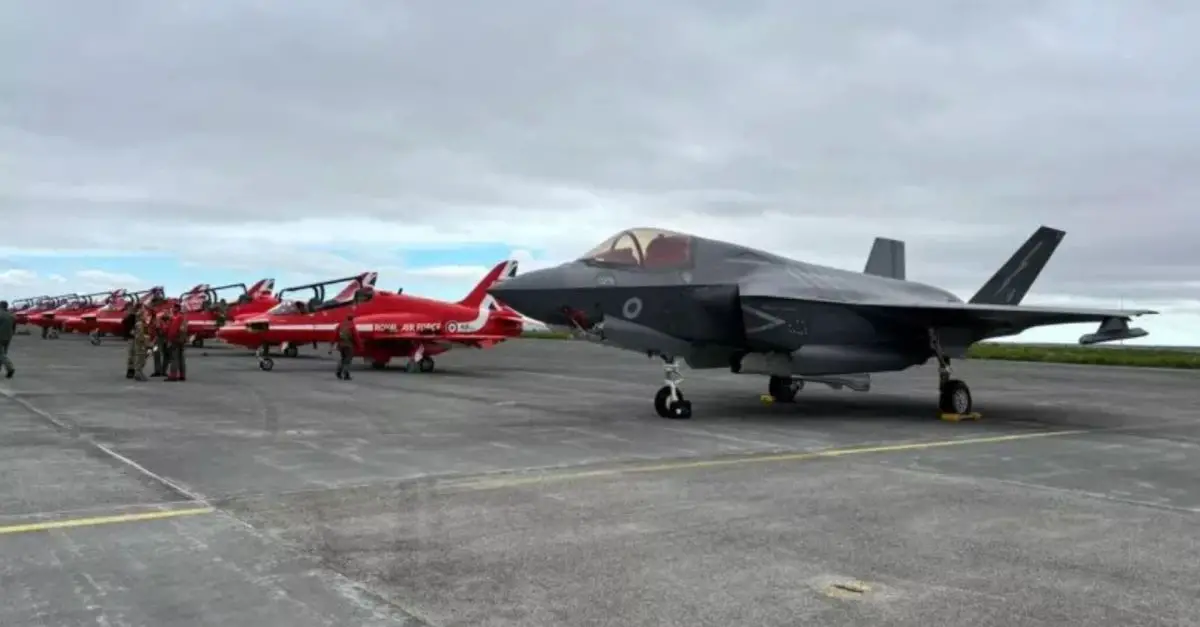Breaking News
NATO countries deploys RAF F-35B jets in Iceland for an Air Policing mission.
Against the strong winds hitting Keflavík Air Base, one of the UK's most advanced stealth fighter jets sits on the tarmac, having just arrived in Iceland. Huddled a few meters from the British Royal Air Force (RAF) F-35B jet, the Icelandic Foreign Minister does not hesitate to acknowledge that the Arctic, just north of the Nordic country, is a region of vital importance.
Follow Army Recognition on Google News at this link

A British Royal Air Force F-35B, right, and aircraft of the Red Arrows aerobatic display team are seen at Keflavík, Iceland, on August 17, 2024. The fifth-generation stealth aircraft are part of a NATO air policing mission based out of Iceland taking place over the next few weeks(Picture source: Ellie COOK )
NATO truly hopes that this region will remain a low-tension zone, but things are changing, and the North Atlantic Alliance must stay vigilant. That's why the UK has sent four F-35B fighter jets from its 617th Squadron to the southwestern tip of Iceland, with the jets just beginning a NATO air policing mission focused on the Arctic.
This is the first time that London's F-35B stealth fighters have participated in NATO air policing missions, although other RAF aircraft have just completed several months of monitoring the eastern flank of the alliance from Romania.
The fast, radar-absorbing fifth-generation jets are designed to be difficult to detect by radar, with the F-35B model capable of landing vertically and taking off over very short distances.
NATO in 2024 is not only monitoring Eastern Europe: it is keeping a close eye on hotspots around the world, from advocating for de-escalation in the Middle East to strengthening its presence in the Indo-Pacific region. There is an increasing sense that NATO is also focusing on the inhospitable Arctic, turning its attention northward as Russia quietly bolsters its presence in the region, and China watches the situation with keen interest. The Alliance has a firm grip on the Arctic region: the vast majority of nations surrounding the Arctic are NATO members, reinforced by the entry of Finland and Sweden into the alliance after Russia launched its full-scale invasion of Ukraine in early 2022.
However, Russia seeks to open a maritime route in the Arctic, taking advantage of global ocean warming and melting ice. A route passing through the north of its territory, within its territorial waters, could be used by international ships, allowing Russia to gain commercial power in the area. In other words, Russia aims to have a role in global trade similar to Iran's influence on oil with the Strait of Hormuz.
In Keflavík, an hour's drive from the Icelandic capital, Reykjavík, the sense is one of solidarity within NATO. Alliance members have repeatedly stated that Russia's invasion of Ukraine has strengthened ties between the two countries, a sentiment reflected at the vast Keflavík Air Base.
The presence of the F-35Bs in Keflavík "is a concrete demonstration of NATO's unity," said RAF Group 11 Commander, Air Vice-Marshal Tom Burke. Iceland continues to be strategically important due to its geographical location, and that certainly does not change when considering the foreseeable shifts in the High North, both due to climate and security situations. Climate change is reshaping the Arctic, opening it up to more traffic and spikes in activity in a region that was previously hard to access.
The transformation of the environment, however, goes hand in hand with the deteriorating relations between Russia and Western countries after Moscow's troops entered Ukraine nearly two and a half years ago. Despite taking heavy blows in Ukraine, Russia has the largest military presence in the region of all Arctic countries and poses a "serious threat," according to the United States. Moscow is busy reopening a number of its Cold War-era facilities, many of which are designed for reconnaissance and surveillance.



























